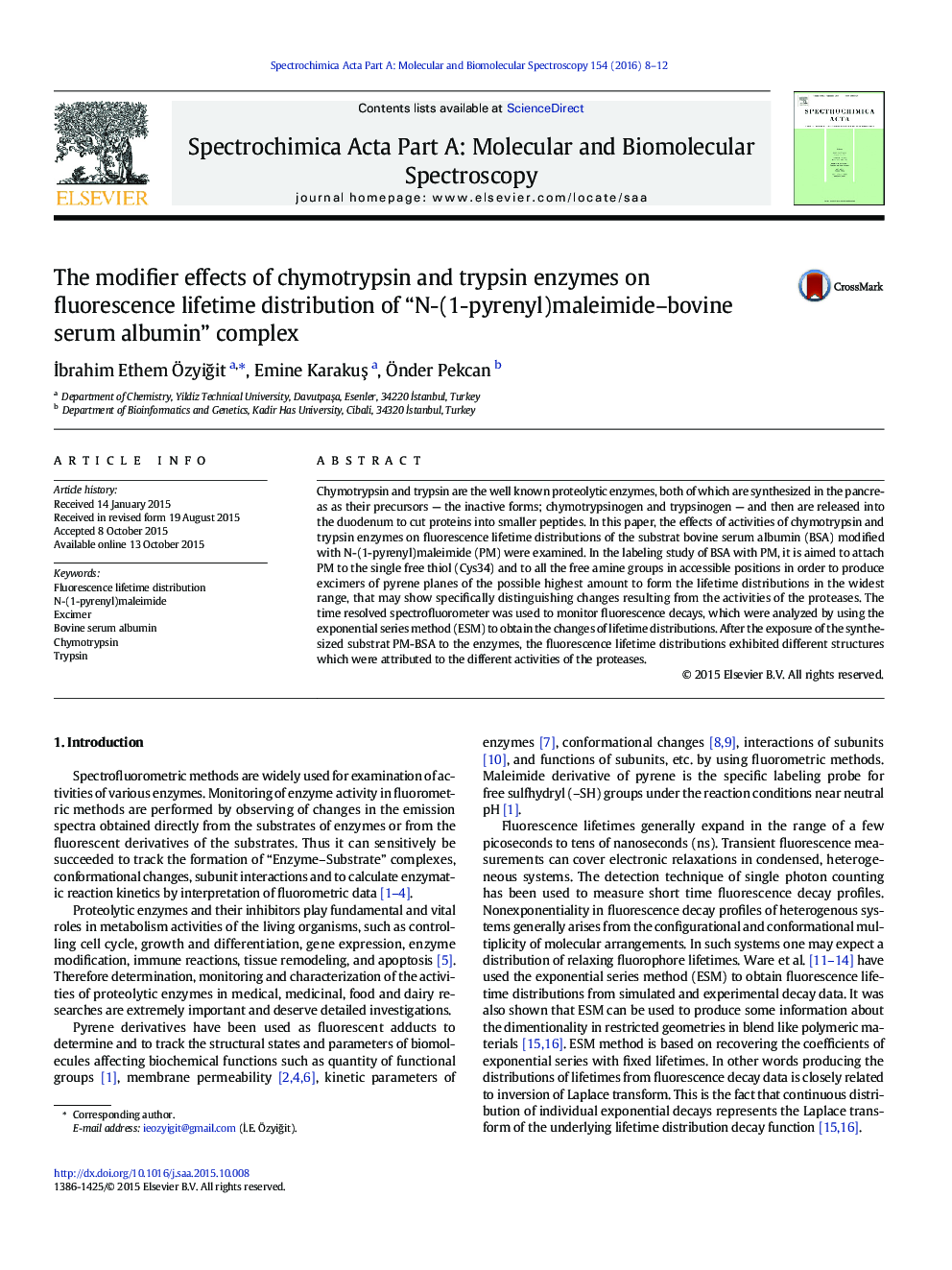| Article ID | Journal | Published Year | Pages | File Type |
|---|---|---|---|---|
| 1231767 | Spectrochimica Acta Part A: Molecular and Biomolecular Spectroscopy | 2016 | 5 Pages |
•The differences between lifetime distributions were proposed for distinguishing the proteolytic activities.•The modification of BSA was achieved so as to produce maximum excimer emission.•The lifetime distribution profiles were obtained with exponential series method (ESM).•Variation of lifetime distributions of the excimer emission exhibited different shapes depending on the acting protease.•The results revealed that the distributional differentiations may serve as specific fingerprint-like indicators.
Chymotrypsin and trypsin are the well known proteolytic enzymes, both of which are synthesized in the pancreas as their precursors — the inactive forms; chymotrypsinogen and trypsinogen — and then are released into the duodenum to cut proteins into smaller peptides. In this paper, the effects of activities of chymotrypsin and trypsin enzymes on fluorescence lifetime distributions of the substrat bovine serum albumin (BSA) modified with N-(1-pyrenyl)maleimide (PM) were examined. In the labeling study of BSA with PM, it is aimed to attach PM to the single free thiol (Cys34) and to all the free amine groups in accessible positions in order to produce excimers of pyrene planes of the possible highest amount to form the lifetime distributions in the widest range, that may show specifically distinguishing changes resulting from the activities of the proteases. The time resolved spectrofluorometer was used to monitor fluorescence decays, which were analyzed by using the exponential series method (ESM) to obtain the changes of lifetime distributions. After the exposure of the synthesized substrat PM-BSA to the enzymes, the fluorescence lifetime distributions exhibited different structures which were attributed to the different activities of the proteases.
Graphical abstractThe comparison of fluorescence lifetime distributions before and after the proteolysis was presented in Fig. 6 where it is seen that the excimers with longer lifetimes around 45 ns decreased and so the distribution widened and shifted to short lifetimes around 30–35 ns for trypsin and to short lifetimes around 8–9 ns for chymotrypsin. On the other hand the excimers with shorter lifetimes around 7 ns decreased and the distribution shifted to shorter lifetimes for trypsin, but in the case of chymotrypsin the distribution presumably shifted to both shorter and longer lifetimes after the proteolysis. These phenomena indicate three reasonable possibilities: 1) the relative positions of the ring planes of adjacent pyrene molecules which are responsible from the excimer formation was broken down as a result of proteolytic destruction of three dimensional structure of PM-BSA complex and some or all the pyrene rings were reoriented to form new excimers with shorter lifetimes in the resultant proteolytic peptide fragments of PM-BSA complex, 2) changing of only the chemical environments of the existing excimers before the proteolysis in the structure of PM-BSA by the proteolytic activity, and 3) occurring of the two processes in a rate and by varying according to acting protease.Figure optionsDownload full-size imageDownload as PowerPoint slide
